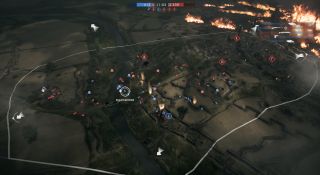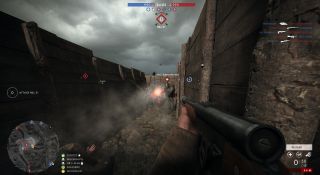Battlefield 1's new River Somme map has the best trenches in the game
Despite the flaws of the Conquest Assault mode, the Apocalypse DLC's Somme map is one of BF1's best.

The trench is my best friend in Battlefield 1. On St. Quentin Scar, I always toss a smoke grenade into point A’s muddy ditches before charging downhill into Travecy. The trench columns bracketing Nivelle Nights’ pockmarked no man’s land are my crooked racetracks for chaining bonks as a club-swinging Trench Raider. Achi Baba’s dusty Mule Trench is a mortarman’s dream. More than bolt-action rifles, mustache curls, or Pickelhauben, the trench is the iconic reminder that yes, it’s World War I again.
For most of BF1’s nearly 30 multiplayer maps, the trench serves as appropriate set dressing but lacks deeper functionality past a slight change in surroundings on the way to an objective. Out of the five new maps introduced in the fresh Apocalypse DLC, it’s fitting that the River Somme, site of one of the bloodiest battles of WW1, at last fully incorporates the trench as a central aspect of its design. Broadly, BF1 isn’t the place for total authenticity—I don't question how a tiny syringe revives someone blasted out of their boots by artillery—but Somme is the most successful map so far at combining the series’ speed with a look and layout that matches my picture of the Great War.
It’s fitting that the River Somme, site of one of the bloodiest battles of WW1, at last fully incorporates the trench as a central aspect of its design.
Somme starts off interesting by opting for the somewhat maligned Conquest Assault mode variation instead of the more nonlinear Conquest. Flag capture is still key, but Conquest Assault places a defending team in control of all points at the round’s start while the attacking team deploys from an unconquerable headquarters. This choice, in part, causes Somme's biggest problem. Battlefield maps triumph or topple based upon how well control points are distributed, and Somme’s zones are conservatively spaced evenly—except for a single area that can turn a round into a frustrating mess.

Point A, Wellington Farm, is pushed so far up against the attacking British team’s headquarters that it guarantees Operations-style clustering and grenade spam at the start of every round. I’m wagering the intent is to explosively illustrate the immense odds the British faced against the dug-in German army, but the point’s isolation from the rest of the map can often lead to aggravating spawn-trapping from a strong German team. The open wheat fields and raised trench line overlooking the farm toughen flank pushes for the Brits, especially if their armor sits back and meekly pelts away from spawn. Spectacle is fun, but repeatedly walking into a meat grinder isn't. I’ve gone entire rounds without seeing the rest of the map beyond A, and after it’s captured, it often sits neglected for the rest of the match.
Thankfully, things get much better. Past the Somme river itself, the head of the trench system crisscrosses an exposed grassy expanse. I like the mixture of open and closed areas, and the emphasis on choice and risk that creates. Somme always offers the safety of the trench against the vulnerability of running on the field, but the trenches are balanced by the latter’s freedom of movement and widened peripheral view. On the flipside, the trench is a comforting built-in shield against armor and snipers, but its blind turns require quicker reflexes. Most of Somme eventually feeds into a trench passage of some sort, and I enjoy how that give-and-take stays with me across nearly the entire map.
The trenches in Somme are one of BF1's best vehicles for strong memories.
Somme’s trenches are some of the most developed of any Battlefield map, easily reaching past head height and narrowing the outside world to cloudy skies. Following the muddy tracks is a tense journey, as my senses are constantly scanning the next turn ahead and for sudden threats that may drop from above.
The confinement of the trench equalizes the stopping power of BF1’s guns, trading hard counters for quick mouse swipes. I spent a round hunting down Support gunners with a Scout’s pistol. In another, I convinced my squad to run from one end of the system to the other wielding nothing but cleavers. I’ve crouched just in time as a Mark V tank thundered across the gap inches from my head, a theatrical moment mirroring single-player scripted sequences. The pickup Flame Trooper kit is spectacularly deadly, a hellish vanguard coating trench walls and soldiers with liquid fire. I’ve collected similar experiences in other Battlefield maps, but the trenches in Somme are one of BF1's best vehicles for strong memories.
The biggest gaming news, reviews and hardware deals
Keep up to date with the most important stories and the best deals, as picked by the PC Gamer team.
Eastward, Somme’s most entertaining points come into play. The E, F, and D zones form a rough triangle representing the German fallback line, and it’s here combat is the most intense. I’m a fan of how D’s trenches stop just short of the crumbling Sugar Mill and Hawthorn Station ruins of E and F, the visual shock of smoke and fire contrasting with the wood and grass of D’s Hill 21. Attackers must go over the top to get close, and I love how that forced exposure necessitates utilitarian tools such as smoke grenades. The ruins are a great stage for last-stand scenarios, as the Germans can use the stronger cover and the safety of map boundaries to pick off threats from D. Alternatively, E and F’s distance from the British spawn is ripe for sneaky rear capture attempts and a nice distraction. The shifting change of ownership between these three points is a welcome constant of infantry-focused activity, especially during fog effects that shorten view distances.

Learn the trench. Love the trench. You’ll be fast friends.
Where Somme falters is in its limited availability across BF1’s modes. Its absence from normal Conquest rotations is disappointing, and it all but screams for its own Operations theater. Conquest Assault, touted as a quicker, more aggressive large-scale Battlefield format, isn’t so much a requirement for Somme to work properly as it is a zerg-blob generator. I don’t like the way teams to flock into roving mobs, crashing into one point after the next, and I yearn for the squad-sized tactics of normal Conquest to take advantage of Somme’s flow.
Faults and all, Somme sits among BF1’s best maps. It strikes a sturdy balance between up-close infantry clashes and the looming power of rolling armor, and though it takes liberties with the historical significance of WWI’s most infamous battle, it effectively recalls the era of trench warfare in a multiplayer setting, a tough accomplishment typically claimed by more realistic counterparts such as Verdun. Learn the trench. Love the trench. You’ll be fast friends.
Omri Petitte is a former PC Gamer associate editor and long-time freelance writer covering news and reviews. If you spot his name, it probably means you're reading about some kind of first-person shooter. Why yes, he would like to talk to you about Battlefield. Do you have a few days?
Most Popular


